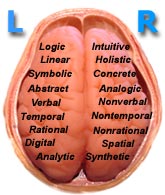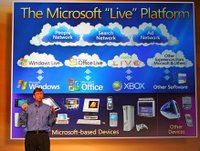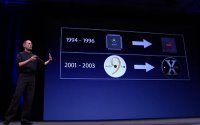Recently, I switched jobs. As a marketer, I was faced with the task of preparing items for my successor while concurrently planning my own agenda as someone’s successor.
As I thought about the quandaries faced by both myself and my successor — how to get up to speed and synthesize data to market an unfamiliar product — I realized that essentially this daunting chore comes down to forging strong relationships with two separate but equally important groups of co-workers.
In a recent post, I mentioned a quote that cited essential pieces of knowledge that all marketers need to create a truly product-centric marketing program — information on the products and the customers. The following two groups of people can help you get both.
Product Development
The people who create your product give you invaluable insight on many of the questions that you need answers to. This product had to be developed for a reason. These are the people to ask. What’s different about the way we make our widget? Is there a secret sauce? It will soon be your job to communicate all of these ideas to the marketplace. You need to soak up as much information from this group as possible.
Sales/Customer Service
I lump these two groups into one super group because titles and org charts aside, basically what I’m saying here is that the second group is the staff on the front lines with your customers. The yin to product development’s yang, these individuals have a unique understanding for why your customers need your product.
And yet it goes beyond that. They know about the market’s values too. They know they don’t just want a better widget. They want a better widget so they can make their lives or the life of their business better. Your front line staff is key to helping you translate the product’s features into a compelling solution that will appeal to your market.
The Point? The whole ‘2 groups of people’ idea initially struck me as a big ‘duh’ but the more I thought about it, the more imperative it became to concretize this concept. Plus, after you mentally label these co-workers as a resource, you then prime your brain to catalog each encounter with these invaluable individuals as an important experience.
Monday, November 28, 2005
Wednesday, November 16, 2005
I AM a Designer (and You Should Be Too!)
 Molli with an “i” is a high school junior who recently job shadowed me for a brief portion of her day. As I talked with her about the minutia of my job as a marketing professional, I mentioned that my favorite part of the day is getting to work with both hemispheres of my brain — the right and the left. The creative and the analytical.
Molli with an “i” is a high school junior who recently job shadowed me for a brief portion of her day. As I talked with her about the minutia of my job as a marketing professional, I mentioned that my favorite part of the day is getting to work with both hemispheres of my brain — the right and the left. The creative and the analytical. “It’s because you’re a designer,” said the very capable designer on the other side of my officle (slang: office + cubicle). I gasped. She was right. I knew she was right because …
Simply put, I love design. I hover over the aforementioned designer’s shoulder all the time and enjoy our collaborations. But it’s not just that. It’s not just thinking of design in the context of graphic design. It’s the reason I love Apple and Target and Old Navy. I love the role that design — in all of its forms — plays in the modern market.
The latter two brands mentioned above are perfect examples. More and more it’s becoming less and less about the quality or price of your product (anyone can and will make a better widget or a cheaper widget). The edge you give your products is its design. Its very essence.
“I’m glad you said it,” I said to my colleague. You see, I’ve always been worried that people would view me as a poser or a dilettante if I labeled myself as a designer so I always watered my explanation down with the generic phrase “I work with designers.”
No more. I have seen the light.
I am a designer because of what I told Molli with an “i.” The fact that, for whatever bipolar reason, my mind (and if you’re reading this, probably yours too) has the ability to toggle between both hemispheres and synthesize real-world data into complex, creative solutions. Right and left. Creative and analytical. Yin and yang.
I am a designer because I think like a designer and approach the world as a design challenge.
The Point? Embrace your inner designer and think of it as your badge of honor that says, “I get why it’s not just about price and quality and ease of use and service anymore.”
Monday, November 14, 2005
How Bad Marketing Almost Caused a Car Accident
 They are tearing up a major thoroughfare near my home. On this road is a new restaurant. On a recent drive home, I was weaving about the construction when I noticed this new restaurant’s sign. Correction: signs. As in three (3).
They are tearing up a major thoroughfare near my home. On this road is a new restaurant. On a recent drive home, I was weaving about the construction when I noticed this new restaurant’s sign. Correction: signs. As in three (3). Not a big deal, right? When you’re a roadside business, your sign is a major tool. Can't hurt to have three of them. However, as you can see here, this restaurateur has made a critical error by implementing three signs with three very different
 logos/typefaces. Ouch.
logos/typefaces. Ouch. Talk about a sending a confusing message. “The Edge” is a relatively vague name for your business. Especially when you use three different logos that offer three very different interpretations.
- Roadside sign — Modern-looking, techy (?) font w/’Restaurant and Tavern’ subheading. This initially had me thinking it was more of a club/meat market …
- Building sign A – Neon, modern script font. A supper club?

- Building sign B – Classical, script font. A classy, high-end ristorante?
Another important lesson that this calls to mind is the one that reminds you not to try to be everything to everyone. This is a recipe for the generic. Make a choice. Pick one of the types of restaurants described above and live that message. Or better yet, work with a designer to capture your new brand's essence visually.
All of these thoughts went flying through my mind at 35 mph in road construction. I narrowly missed putting the car into the ditch. Bad marketing can mess up your day big time.
The Point? You can’t be everything to everyone so don’t try. Pick something and do it steadfastly and consistently. And get a professional designer (at least for your logo!).
The Punchline? All of this curiosity did make me try the restaurant and it was great. (FYI: Probably more of a sign #2 – building sign A. It was classy but still with some funk).
Thursday, November 10, 2005
Avoid Marketing Graft
I’m not talking about the graft and vice definition of graft. The graft I’m talking about is the broad definition used to describe the process of joining one thing to another. Like a skin graft.
I use this term in marketing because often times it seems that marketing is grafted onto a product or service that just appears for marketers to make Shinola out of. Sound familiar?
Marketers: Change starts with you. Close up your product development feedback loops. Don’t let yourself be defined in the process as merely the next one to get the hand-off in the development cycle. Involve yourself. If there’s no process in place for marketing involvement — create one.
The only way to reach product nirvana, with an eventual result of achieving maximum marketing velocity, is for all parties to come together (including potential customers) and be involved in development collaboratively. Marketers proximity to product development serves more than just the product, though. It also creates more effective, product-centric marketing.
The quote below says it best.
I use this term in marketing because often times it seems that marketing is grafted onto a product or service that just appears for marketers to make Shinola out of. Sound familiar?
Marketers: Change starts with you. Close up your product development feedback loops. Don’t let yourself be defined in the process as merely the next one to get the hand-off in the development cycle. Involve yourself. If there’s no process in place for marketing involvement — create one.
The only way to reach product nirvana, with an eventual result of achieving maximum marketing velocity, is for all parties to come together (including potential customers) and be involved in development collaboratively. Marketers proximity to product development serves more than just the product, though. It also creates more effective, product-centric marketing.
The quote below says it best.
“The advertising man is a liaison between the products of business and the mind of the nation. He must know both before he can serve either.” – Glenn Frank
Monday, November 07, 2005
Less Like Bill. More Like Steve.
"I wish the stage were as narrow as the wire of a tightrope dancer, so that no incompetent would dare step upon it."– Johann Wolfgang von Goethe
 Bill Gates is obviously not up on his Goethe. This recent presentation, which has been called "one of the most poorly executed events I've seen Microsoft do in years," was pointed out to us by both Seth Godin and Garr Reynolds. The latter has an extremely detailed analysis on Zen presentation (he even goes so far as to observe Mr. Gates' closed-off presentation style that makes him look like The Simpsons' Mr. Burns).
Bill Gates is obviously not up on his Goethe. This recent presentation, which has been called "one of the most poorly executed events I've seen Microsoft do in years," was pointed out to us by both Seth Godin and Garr Reynolds. The latter has an extremely detailed analysis on Zen presentation (he even goes so far as to observe Mr. Gates' closed-off presentation style that makes him look like The Simpsons' Mr. Burns).This screenshot stands in stark
 contrast to Steve Jobs at ... um ... every keynote he's done. Even if you're not a computer nut it's worth watching an Apple keynote to gain some valuable insight on making your next presentation into an event.
contrast to Steve Jobs at ... um ... every keynote he's done. Even if you're not a computer nut it's worth watching an Apple keynote to gain some valuable insight on making your next presentation into an event. Too many people hop up in front of an audience that they assume is captivated (but ends up being captive — in the bad sense) without fully realizing the gravity of Goethe's words. You have a responsibility when you are presenting. A responsibility to your audience to communicate your message. Don't take this for granted. Practice. Videotape yourself. Learn how to put together an effective and concise PowerPoint presentation (not just a teleprompter or virtual note cards).
Presentation is less like writing an inner-office memo and more like a major communications channel that deserves the attention you give the rest of the pieces of your marketing plan. Remember Goethe's words and be prepared. (The Apple addict strikes again!)
Friday, November 04, 2005
Firefox Gets Viral
 If you haven’t checked out Firefox, the simple, quick-loading, secure browser that's gaining traction among consumers eager for an alternative to Microsoft IE, you’re missing out.
If you haven’t checked out Firefox, the simple, quick-loading, secure browser that's gaining traction among consumers eager for an alternative to Microsoft IE, you’re missing out. But technical wonderment aside, what should also be taken note of are the viral marketing efforts surrounding this product. When I first downloaded the browser, their simple interface directed to spread the good word about Firefox. This link took me to SpreadFirefox.com, a site that hosts related blogs and gives eager users the tools they need for converting the masses.
At first glance, this movement made me think that the Spread Firefox campaign was the Howard Dean of browsers (minus the scream and the eventual burnout). Turns out that the Spread Firefox site was built on Civic Space, the same software behind Dean’s groundbreaking online campaign.
If you need helping imagining how can make your product or service more viral (getting your customers to spread your ideas for you), use Spread Firefox to get started. Maybe you can come up with a contest among users, easy tools for adding a link to your site, maybe someone would even purchase apparel touting your product or service.
All of these viral strategies and many more are currently in play on the Spread Firefox site and challenging you to step up and get viral with your business.
To learn more about the backstory of Firefox, check out this article from Wired or discover for yourself by downloading Firefox now for free.
Wednesday, November 02, 2005
Bob and Willie
 This summer I had the privilege of seeing Bob Dylan and Willie Nelson in concert together. In thinking about these two giants, it occurred to me that their personal success stories provide two very different allegories for business today.
This summer I had the privilege of seeing Bob Dylan and Willie Nelson in concert together. In thinking about these two giants, it occurred to me that their personal success stories provide two very different allegories for business today. As everyone knows, young Robert Zimmerman created Bob Dylan. But Bob didn’t just create a name — he created a story. In early interviews he basically wrote a back story (read: made stuff up) for this character, Bob Dylan.
Everything from working on a ranch in New Mexico to variations on his personal heritage were carefully crafted by Bob who, as a reluctant but nonetheless savvy marketer knew this story would catch on much faster and with greater impact than the story of a kid from Minnesota’s Iron Range that comes to the big city and makes it. Not mysterious enough plus it didn’t have the appeal that he knew his core audience (‘60s folkies) would adopt and take to the masses.
Think of Bob Dylan as a new business. First on the scene with a great idea but no real compelling story that could take this guy who makes great music and transform him into an institution. What Bob added to the mix to achieve the latter was the story. Before marketing himself, he took the time to answer the question “Who is this guy,” basically defining the story for his product.
Willie Nelson, on the other hand, had to have a “do over.” In Nashville in the early ‘60s while Bob was making it big, Willie had carved out a modest niche for himself as a songwriter. But penning “Crazy” for Patsy Cline and “Hello Walls” for Faron Young wasn’t enough. So a suit-wearing, clean-shaven Willie worked to become a country singer. At the end of the day though, this Willie wasn’t anything special.
 Defeated, he returned to Texas, failed at pig farming, and eventually formed a little band on his terms. Noticing the counter culture scene near Austin and observing it cross-pollinating with country he found a new segment of the audience that no one was speaking to. This innovation yielded the birth of ‘70s outlaw country and Willie’s new character, the Red-Headed Stranger. This character, like Bob’s creation, was fully formed and had a story that was adoptable by the core audience that would take his music to the mainstream.
Defeated, he returned to Texas, failed at pig farming, and eventually formed a little band on his terms. Noticing the counter culture scene near Austin and observing it cross-pollinating with country he found a new segment of the audience that no one was speaking to. This innovation yielded the birth of ‘70s outlaw country and Willie’s new character, the Red-Headed Stranger. This character, like Bob’s creation, was fully formed and had a story that was adoptable by the core audience that would take his music to the mainstream.Think of Willie as the business at the dead end. Several companies find that their corporate messaging needs a “do over” like the one Willie gave his story. Don’t be afraid of reinvention.
A question every marketer at every company should ask is “Who are we?” It’s a complicated question that is easily dodged or vaguely answered but must be defined in great detail. You need to figure out who your company is and thus what your story is.
These two allegories apply to defining who your company is no matter what your product or service is. If you are in the professional services industry, the lesson should be incredibly apparent. It’s not enough to just show up and do the job. That’s what the customer expects. If you answer the question of who you are, you infuse your customer’s experience and make them more likely to adopt your brand of service and, if you’re lucky, they’ll take you to the mainstream like “Blowin’ in the Wind” and “Whisky River.”
Tuesday, November 01, 2005
The Complexity of "Easy to Use"
You're sitting down to discuss your message strategy with your boss or client. He's listing off the product or service's core features and rounding out the list is its ease of use. Gulp! You're really in trouble if the first two on the list were the product's high quality and low price.
That's because "easy to use" is now an equal to "high quality" and "low price" when it comes to cliche product features. Bernard Taper asserted, "a cliche is a truth that no one believes." You can now join me in welcoming ease of use to this auspicious club of cliches that no one believes anymore.
More importantly, your customers now expect ubiquitous product features like easiness. What can you do? Exclude ease from your messaging? No. You just need to use some additional tools to better define the complex issue that is your product's ease of use.
Target the Solution
In order to be considered "easy," your product or service presumably makes some aspect of your customers' life easier. Find that fulcrum and leverage it. Focus on what is actually made easy for the customer by your product and less on the general malaise of your product's ease.
Design Easy
(Designers take note: I didn't say design was easy!). Isn't it ironic when you're reviewing marketing collateral touting a product's ease of use and the piece itself is busy, text-heavy, and overly complicated? One of the most powerful ways to communicate your product's ease is through design. Convey ease through design that is open, deliberate, and simple.
Putting It All Together
Part of the reason that product ease became cliche is that too many marketers became dependant on the generic label of "easy to use." This is not enough anymore. You need to develop a system of ease into your message strategy that incorporates the ease to the customer and pulls in elements from your product development cycle. This allows you to tell your product's story of ease, loaded with features, within the context of your customer's problem. With your system of ease packaged, you wrap it up in the ease-centered design touched on above.
So next time you get the complex assignment of selling "easy," remember to use these three tools to help you define it.
That's because "easy to use" is now an equal to "high quality" and "low price" when it comes to cliche product features. Bernard Taper asserted, "a cliche is a truth that no one believes." You can now join me in welcoming ease of use to this auspicious club of cliches that no one believes anymore.
More importantly, your customers now expect ubiquitous product features like easiness. What can you do? Exclude ease from your messaging? No. You just need to use some additional tools to better define the complex issue that is your product's ease of use.
Target the Solution
In order to be considered "easy," your product or service presumably makes some aspect of your customers' life easier. Find that fulcrum and leverage it. Focus on what is actually made easy for the customer by your product and less on the general malaise of your product's ease.
Design Easy
(Designers take note: I didn't say design was easy!). Isn't it ironic when you're reviewing marketing collateral touting a product's ease of use and the piece itself is busy, text-heavy, and overly complicated? One of the most powerful ways to communicate your product's ease is through design. Convey ease through design that is open, deliberate, and simple.
Putting It All Together
Part of the reason that product ease became cliche is that too many marketers became dependant on the generic label of "easy to use." This is not enough anymore. You need to develop a system of ease into your message strategy that incorporates the ease to the customer and pulls in elements from your product development cycle. This allows you to tell your product's story of ease, loaded with features, within the context of your customer's problem. With your system of ease packaged, you wrap it up in the ease-centered design touched on above.
So next time you get the complex assignment of selling "easy," remember to use these three tools to help you define it.
Subscribe to:
Posts (Atom)



